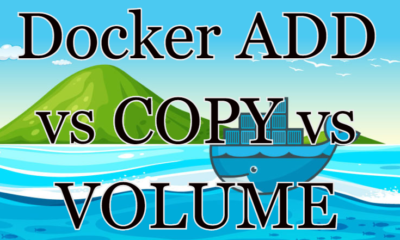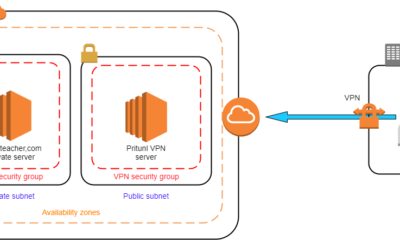DevOps
Containerization Basics With Podman And Docker on Linux: A Guide
Imagine having the power to run applications reliably across different computing environments without hiccups. That’s the magic of containerization, and it’s within your reach with tools like Podman and Docker on Linux.
Whether you’re a seasoned developer or just starting out, understanding these basics can revolutionize the way you manage and deploy applications. You might wonder why containerization is gaining traction and how it can benefit you. In this guide, you’ll discover the essentials of using Podman and Docker, unraveling the complexities of containerization in a straightforward way.
Get ready to streamline your workflows and enhance your efficiency. Dive in, and see how mastering these tools can transform your approach to development.

Credit: medium.com
What Is Containerization?
Containerization is a method to run software reliably across different environments. It packages an application and its dependencies into a container. This container can run on any system that supports it. It simplifies the process of deploying software.
Containers ensure the application runs the same everywhere. They are lightweight and start quickly. Developers and IT teams use them to manage software efficiently.
What Defines A Container?
A container is a unit of software that holds code and dependencies. It makes sure the application works consistently across platforms. Containers use a shared operating system but have isolated processes.
Benefits Of Containerization
Containers offer several advantages. They use fewer resources and start faster than virtual machines. Containers simplify development and testing processes. They help in creating a consistent environment from development to production.
Containerization In Linux
Linux is a popular choice for containerization. It supports tools like Docker and Podman. These tools help in creating, managing, and running containers. They are vital for modern software development.
Introduction To Podman And Docker
Containerization is an essential part of modern software development. It helps in packaging applications and their dependencies, ensuring consistency across environments. Podman and Docker are popular tools that enable this process on Linux systems. They provide a simple way to create, deploy, and manage containers efficiently.
Introduction To Podman
Podman is an open-source tool for managing containers. It works without a daemon running in the background. This feature makes Podman more secure and lightweight. Users can run containers as root or non-root, enhancing flexibility.
Podman commands are similar to Docker, easing the transition for users familiar with Docker. It supports Kubernetes, allowing users to generate Kubernetes YAML from existing containers. Podman can also manage pods, which are groups of containers. This capability is beneficial for orchestrating complex applications.
Introduction To Docker
Docker is a widely-used container platform. It provides a comprehensive ecosystem for container management. Docker daemon runs in the background, managing containers and images. This approach simplifies container operations but requires root privileges.
Docker supports a vast range of tools and extensions. It integrates well with CI/CD pipelines, speeding up development workflows. Docker Hub offers a large repository of container images, simplifying image distribution. Users can easily pull and push images, enhancing collaboration.
Comparison Of Podman And Docker
Podman and Docker both offer robust container management features. Podman is daemonless and can run containers as a regular user. Docker relies on a daemon, providing centralized control. Podman is often preferred for security-conscious environments.
Docker has a larger community and ecosystem. Podman is gaining popularity, especially for Kubernetes integration. Both tools support OCI standards, ensuring compatibility and interoperability. Choosing between them depends on specific project needs and security considerations.
Installing Podman On Linux
Are you ready to dive into the world of containerization on Linux but not sure where to start? Installing Podman is a great first step. Podman is a powerful tool that allows you to manage containers effortlessly on Linux. Unlike Docker, Podman operates without a daemon, offering a more straightforward and secure approach. Let’s get your Linux environment ready for Podman and explore how to install it seamlessly.
System Requirements
Before installing Podman, ensure your system meets the necessary requirements. Podman is compatible with most Linux distributions, including Fedora, CentOS, Ubuntu, and Red Hat Enterprise Linux. Make sure your Linux kernel is version 3.10 or higher. This is essential for supporting container features.
Your system should have sufficient disk space and memory. A minimum of 2GB RAM is recommended for smooth operations. Additionally, verify if you have sudo privileges. This will allow you to execute commands required for installation.
Installation Steps
Installing Podman is straightforward and can be completed in a few steps. Let’s get started:
- Update your system: Begin by updating your system’s package repository. Open the terminal and run
sudo apt updatefor Debian-based systems orsudo yum updatefor Red Hat-based systems. Keeping your system updated ensures compatibility. - Install Podman: With your system updated, you can proceed to install Podman. Use the command
sudo apt install podmanfor Ubuntu and Debian systems. For Fedora and CentOS, usesudo yum install podman. Installation will take a few minutes. - Verify Installation: Once installed, verify Podman’s version by typing
podman --versionin the terminal. This confirms the installation was successful and Podman is ready to use.
Podman is now installed on your Linux system. The simplicity of these steps makes it accessible even for beginners. You are now prepared to start managing containers efficiently!
Have you ever wondered what makes Podman a preferred choice over Docker for many developers? It’s the rootless container management and seamless integration with Linux systems. With Podman, you have more control and flexibility. Now that you have it installed, what will you build first?
Installing Docker On Linux
Docker is a popular tool for containerization on Linux. It simplifies application deployment by isolating software in containers. This section will guide you through installing Docker on a Linux system. Whether you’re a developer or a curious learner, understanding Docker’s setup is essential.
System Requirements
Before installing Docker, ensure your system meets the requirements. You need a 64-bit Linux OS. Check your kernel version; it should be 3.10 or higher. Docker supports Debian, Ubuntu, CentOS, and Fedora. Ensure your system has enough disk space, at least 10 GB free. Also, verify internet connectivity for downloading packages.
Installation Steps
First, update your package index using the command: sudo apt update. This ensures you have the latest package listings.
Next, install Docker’s dependencies. Run: sudo apt install apt-transport-https ca-certificates curl software-properties-common.
Now, add Docker’s official GPG key. Use the command: curl -fsSL https://download.docker.com/linux/ubuntu/gpg | sudo apt-key add -.
Add the Docker repository to your system. For Ubuntu, type: sudo add-apt-repository "deb [arch=amd64] https://download.docker.com/linux/ubuntu $(lsb_release -cs) stable".
Update your package index again with: sudo apt update. This ensures the Docker repository is included.
Install Docker using the command: sudo apt install docker-ce. This command installs the community edition of Docker.
Finally, verify the installation. Run: sudo docker --version. You should see the Docker version number.
Basic Commands In Podman
Podman is a tool for managing containers on Linux. It offers a simple and effective way to work with containerized applications. Understanding basic commands in Podman helps streamline container management. This section explores key commands for creating and running containers, along with managing container images.
Creating And Running Containers
Creating containers is straightforward with Podman. Use the command podman run to start a new container. This command fetches the container image and runs it. For instance, podman run -d nginx starts an Nginx container in the background. The -d flag ensures the container runs detached. Podman handles containers without needing a daemon, making it efficient.
To view running containers, use podman ps. This command lists all active containers. For stopping containers, podman stop [container_id] is handy. Replace [container_id] with the actual ID from the list. Removing containers is simple with podman rm [container_id]. This helps keep your system clean.
Managing Container Images
Podman also excels in managing container images. The podman pull command fetches images from registries. For example, podman pull ubuntu downloads the Ubuntu image. To list all local images, use podman images. This command shows image names, IDs, and sizes.
Removing unused images saves space. Use podman rmi [image_id] to delete images. Ensure you replace [image_id] with the correct ID from your image list. To update images, pull the latest version using podman pull. This ensures you have the most current image features.

Credit: www.instagram.com
Basic Commands In Docker
Exploring containerization with Podman and Docker on Linux involves mastering basic commands like `run`, `stop`, and `remove`. These commands efficiently manage containers, ensuring streamlined operations and enhanced productivity. Understanding them is crucial for anyone diving into Linux-based containerization.
Navigating the world of containerization can initially seem daunting, but understanding the basic commands in Docker can make the journey smoother. Docker is a powerful platform that allows you to automate the deployment of applications inside lightweight, portable containers. Knowing a few essential commands is the key to efficiently managing your Docker environment on Linux. ###Creating And Running Containers
Starting with Docker involves creating and running containers. The `docker run` command is your go-to tool. This command not only creates a container but also runs it. For instance, `docker run hello-world` will fetch the ‘hello-world’ image from Docker Hub and run it, displaying a friendly hello message. You might wonder, why is this command so powerful? Because it simplifies the process of deploying apps, letting you focus on development rather than infrastructure. What application will you containerize first? Starting a container in the background, like a daemon, is also possible with `-d` option, for example, `docker run -d nginx` starts an NGINX server. This means you can continue using your terminal while the container runs in the background. This command opens up possibilities for multitasking. ###Managing Container Images
Managing images effectively is crucial for optimizing Docker’s use. The `docker pull` command is used to download images from Docker Hub. For example, `docker pull ubuntu` downloads the latest Ubuntu image, setting the stage for building customized environments. Listing images on your system is straightforward with `docker images`. This command provides a table of available images, helping you track what’s installed. Keeping an eye on your images ensures you have the right tools at your disposal. Have you considered cleaning up unused images? The `docker rmi` command lets you remove images that are no longer needed. For instance, `docker rmi ubuntu` deletes the Ubuntu image. Efficient image management can save storage space and keep your system organized. These commands are the building blocks of your Docker experience. By mastering them, you gain control over your containerized applications, paving the way for more advanced Docker functionalities. What new projects could you start once you’ve mastered these basics?Comparing Podman And Docker
Containerization has changed software development on Linux. Podman and Docker are two popular tools. They help manage containers. But they have some differences. Understanding these differences helps choose the right one.
Key Differences
Docker uses a client-server model. It requires a daemon to run. This daemon manages containers. Podman does not need a daemon. It runs containers directly. This makes Podman more secure.
Podman supports rootless containers. Users can run containers without root privileges. Docker requires root access. This can be a security risk. Podman’s approach reduces risks.
Docker has a single command-line interface. Podman splits commands into smaller tools. This gives users more flexibility. They can choose the right tool for their needs.
When To Use Each
Choose Docker for ease of use. Its ecosystem is mature. Many developers are familiar with it. It has a large community. This means more resources and support.
Podman is great for security-focused projects. Its rootless feature is appealing. Developers working on secure systems prefer Podman. It minimizes risks.
If you need to manage many containers, Docker might be better. Its daemon can handle many tasks at once. Podman is better for single or smaller workloads. Its direct execution model is lightweight.

Credit: developers.redhat.com
Security Considerations
Containerization on Linux using tools like Podman and Docker offers a streamlined approach to deploying applications. However, security is a crucial aspect that you should never overlook. As you explore the world of containers, understanding how to secure them effectively can protect your data and systems from vulnerabilities. Let’s dive into some key security considerations.
Rootless Containers
Running containers as non-root users is a powerful security strategy. Rootless containers help limit the potential impact of a security breach. By running containers without elevated privileges, you reduce the risk of a compromised container gaining control over your host system.
Podman excels in supporting rootless containers, allowing you to manage your containers without needing sudo access. This approach not only enhances security but also provides flexibility. Imagine working in a shared environment where you don’t have root access—rootless containers empower you to run applications securely.
Have you tried setting up a rootless container? It’s surprisingly straightforward. You simply use Podman commands as a regular user. This practice could be the key to maintaining robust security in your container ecosystem.
Managing Container Permissions
Permissions play a vital role in container security. You need to carefully manage which resources a container can access. Over-permissioning can expose your system to risks, while under-permissioning might hinder functionality.
Docker provides mechanisms such as user namespaces and capabilities to fine-tune permissions. You can specify what a container can and cannot do on the host. For instance, if a container doesn’t need network access, you can restrict it to minimize exposure.
Think about your last container deployment. Did you scrutinize the permissions? It’s essential to periodically review and adjust them according to your application needs and security protocols.
By paying attention to these security considerations, you can strengthen your containerized applications on Linux. What security measures are you taking to protect your containers? Share your experiences and insights in the comments below!
Best Practices For Containerization
Discover containerization with Podman and Docker on Linux. Streamline app deployment using lightweight containers and efficient orchestration. Enhance system scalability and resource management by adopting these powerful tools.
Containerization has transformed how we deploy and manage applications, and tools like Podman and Docker have made it incredibly accessible. Yet, achieving effective containerization on Linux requires adopting best practices to optimize performance and security. Let’s explore how you can enhance your container strategies with some practical tips and techniques.Optimizing Container Performance
To get the most out of your containers, focus on performance. Start by keeping your container images as small as possible. A lean image reduces startup time and minimizes resource usage. Use multistage builds in your Dockerfile to compile only what you need. Limit the number of layers in your images. Each layer adds overhead, so fewer layers mean faster deployments. Do you really need that extra package? If not, ditch it. Allocate resources carefully. Set limits on CPU and memory usage to ensure your containers run smoothly without hogging your system. This prevents one container from overwhelming your entire server.Ensuring Container Security
Security should be a top priority in containerization. Regularly update your base images and dependencies to protect against vulnerabilities. An outdated image is an open invitation for threats. Use non-root users inside your containers whenever possible. Running as root increases the risk of security breaches. It’s a simple change that can make a significant difference. Network security is crucial. Define explicit network policies to control traffic between containers and external sources. Consider using tools like SELinux or AppArmor to add an extra layer of security. Implement logging and monitoring practices. Keeping track of container activities helps you detect and respond to suspicious behavior. Are you prepared for unexpected events? Containerization offers immense benefits, but only if done right. By optimizing performance and ensuring security, you can make the most of Podman and Docker on Linux. Are you ready to elevate your container game?Troubleshooting Common Issues
Containerization with Podman and Docker on Linux often faces common issues. Troubleshooting involves checking network configurations, managing resource allocations, and understanding error logs to ensure seamless operations. Mastering these basics enhances container efficiency and stability.
Containerization has revolutionized the way applications are deployed, but like any technology, it comes with its own set of challenges. When working with Podman and Docker on Linux, you might encounter issues that can halt your progress. Understanding how to troubleshoot these common problems can save you time and frustration. Whether you’re a seasoned developer or a newbie, knowing the ins and outs of these tools can make your container journey smoother. Let’s dive into some practical strategies to tackle frequent issues.Podman Troubleshooting
Podman, known for being daemonless, can sometimes throw unexpected errors that might leave you scratching your head. You might encounter connectivity issues when your containers fail to network correctly. One common problem is containers not being able to access the internet. Check your network configuration and ensure that Podman’s default network settings haven’t been altered. Have you ever tried running a container only to find out it won’t start? Consider verifying the container image. An image might be corrupted, or it might have dependencies that aren’t met. Permissions can also be a headache. If you face permission denied errors, inspect the user privileges under which Podman is running. Adjusting user settings can often resolve these hiccups.Docker Troubleshooting
Docker, while robust, is not immune to issues. A typical problem users face is Docker daemon failing to start. This can arise from corrupted configuration files or insufficient system resources. You might encounter network bridge conflicts. This happens when Docker’s default bridge overlaps with existing network settings. Adjusting Docker’s network settings can often resolve this. Ever seen containers failing to build or run? Check the Dockerfile syntax. An incorrect command or a missing step in the Dockerfile can halt the build process. Docker volumes can sometimes not mount as expected. Verify if the paths are correct and that the necessary permissions are set. How do you handle these challenges? Do you have any tips that have worked for you? Addressing these issues head-on with practical solutions can turn potential roadblocks into learning opportunities. Embrace the troubleshooting process as a way to deepen your understanding of containerization.Frequently Asked Questions
Can You Have Podman And Docker On The Same Machine?
Yes, you can have both Podman and Docker on the same machine. They operate independently without conflicts. Make sure to manage the environment paths correctly to avoid command confusion. Podman is rootless by default, providing added security. Docker requires root privileges, but both can coexist seamlessly.
What Is The Difference Between Docker And Podman In Linux?
Docker uses a daemon for managing containers, while Podman is daemonless. Podman supports rootless containers for enhanced security. Docker requires a running background service. Podman offers a similar command-line interface, making it easy to switch. Podman containers can be run as systemd services.
Both tools are popular in Linux environments.
Can You Run Docker Containers With Podman?
Yes, Podman can run Docker containers directly. It uses a similar syntax to Docker, making it easy to transition. Podman is rootless, enhancing security. It supports Docker images and commands, offering a seamless experience for developers familiar with Docker. Podman is an excellent choice for container management.
How To Build A Docker Image With Podman?
Use Podman to build a Docker image by executing `podman build -t image_name. ` in your terminal. Ensure the Dockerfile is in the current directory. Podman offers Docker compatibility and rootless operation, enhancing security.
Conclusion
Mastering containerization with Podman and Docker boosts your Linux skills. Both tools simplify app management. Podman offers rootless operation, enhancing security. Docker provides widespread support and robust features. Choosing between them depends on your needs. Podman suits those prioritizing security and ease.
Docker appeals with its comprehensive ecosystem. Experimenting with both enriches your understanding. Containers streamline development and deployment. They enhance flexibility and efficiency in managing applications. Dive into containerization on Linux today. Embrace the power of Podman and Docker for modern software solutions.
-

 DevOps6 years ago
DevOps6 years agoSaltstack Tutorial for beginners [2025]
-

 DevOps6 years ago
DevOps6 years agoHow to build a Docker cron job Container easily [2025]
-

 Linux7 years ago
Linux7 years agomail Command in Linux/Unix with 10+ Examples [2025]
-

 DevOps6 years ago
DevOps6 years agoDocker ADD vs COPY vs VOLUME – [2025]
-

 DevOps6 years ago
DevOps6 years agoHow to setup Pritunl VPN on AWS to Access Servers
-

 Linux7 years ago
Linux7 years agoGrep Command In Unix/Linux with 25+ Examples [2025]
-

 Linux7 years ago
Linux7 years agoFind command in Unix/Linux with 30+ Examples [2025]
-
Linux5 years ago
How To setup Django with Postgres, Nginx, and Gunicorn on Ubuntu 20.04

